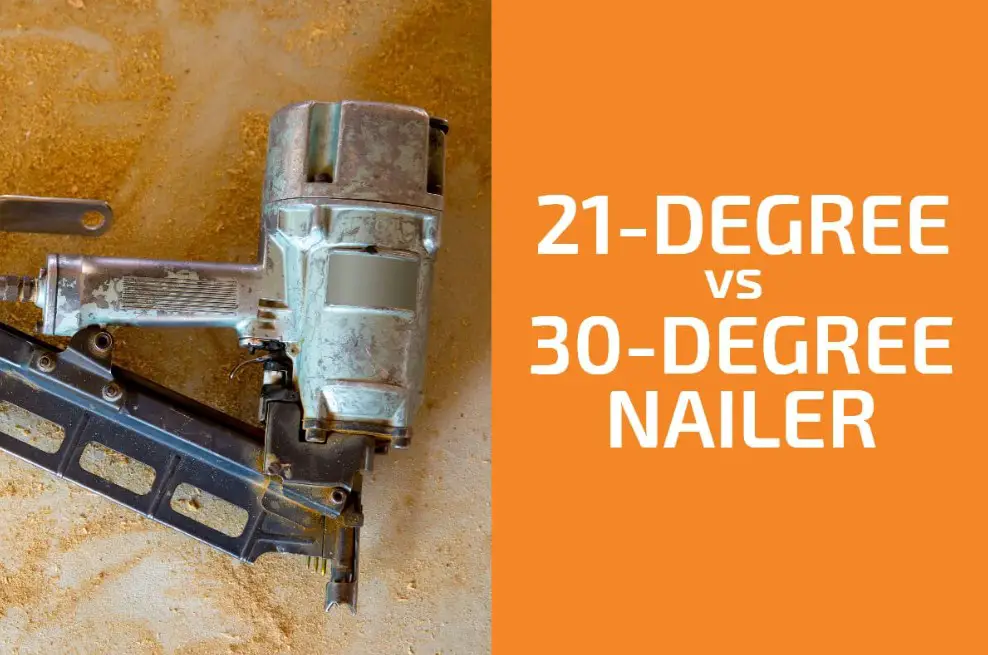Performance Evaluation: 21 vs. 30 framing nailer
People look for framing nailers when purchasing a nailer to handle large wood framing tasks. They locate both a 21-degree and a 30-degree framing nailer in the marketplace and choose one at random.
A nail gun is necessary for creating fences, wood siding, and house frames. However, people occasionally choose the incorrect framing nailer angles.
The 21 vs. 30-degree frame nailer will be thoroughly discussed in this post.
Why do framing nailers have different angles?
The framing nails’ angle must first be understood. The degree of the framing nailer angle indicates the ideal angle at which a framing nailer can fire nails. For instance, you can have usable access to a 30- degree angle if you have a 30-degree framing nailer.
A framing nailer’s magazine is typically filled with nail strips that are dangling at an uninteresting angle. A framing nailer’s broad angle makes it easier to access even the tightest spot. A framing nail gun comes in a variety of angles to make them more versatile for use with various projects.
21-degree nail gun
Driving stronger nails requires the use of a 21-degree frame nailer. Since it has a 21-degree collation, the 21-degree framing nailer derives its name from the angle of the magazine that it can handle.
Details
The 21-inch frame nailer can drive nails up to 3-1/2 inches, unlike most ordinary nailers that can only drive nails up to 2-1/2 inches.
Despite being slightly heavier than a conventional nailer, the 21-inch framing nailer is a need for anyone who works with timber due to its increased power and capacity.

When might a framing nailer with a 21-degree angle work for you?
A 21-degree framing nailer may be ideal for you if your needs are heavy-duty. Let’s talk about some tasks where a 21-degree framing nailer might be appropriate:
- heavy construction projects
- building a house from wood
- a wooden fence
- sheathing works
- roof decking maintenance
- putting in subfloors
- siding works
- pallet production
- truss construction

30-degrees nail gun
A 30-degree framing nailer is a wonderful option if you require a nailer that can handle several tasks. A 30-degree framing nailer retains its magazine at a 30-degree collation and is intended for use in framing applications. It can be applied to a variety of tasks, including subfloor installation and the attachment of floor joists.
Details
A stronger joint is produced by driving the nails into the wood at the proper angle, which is ensured by the nail gun’s angled head. This nailer’s ability to work with a variety of nails is one of its amazing features.

When might a 30-degree framing nailer work for you?
A 30-degree frame nailer is one of the better options when it comes to nailing in the most difficult corner. Take a look at some projects where a 30-degree framing nailer may be appropriate:
- framing nail collation
- siding
- decking
- fencing
- large-scale nail-driving tasks
- projects for trimming the furniture to reach its most difficult corner

Comparing two framing nailers (nail guns)
While most jobs can use either of these two frame nailers interchangeably, there are a few things to keep in mind.
Magazines and framing nails
In comparison to other cordless framing nailers, the 21-degree framing nailer has a magazine that can contain two strips of nails, totaling about 60 framing nails.
Typically, magazines are packaged in 20- to 22-degree plastic strips.
The 21-inch frame nailer can drive nails up to 3-1/2 inches, unlike most ordinary nailers that can only drive nails up to 2-1/2 inches.
Application of a nail gun
This makes it perfect for applications like siding and framing that call for a stronger hold. Additionally, this nailer has a depth control that can be adjusted, allowing the user to alter the depth of each nail.
Compared to the 21-degree nailer, the 30-degree nailer is a more adaptable instrument that works well for a variety of jobs.
It is perfect for a variety of tasks and can blast nails from 2′′ to 3 1/2′′. It has a collation of thin wire strips, which is more common than plastic strips, the same as paper strips.
However, keep in mind that wetness has the propensity to harm the paper strips. You might need two thin wire strips here.
Longer projects benefit from the 30-degree framing nailers’ capacity of 88 nails because you won’t need to reload them as frequently. You have additional options for the kinds of head nails you can use because they can handle clipped head nails or offset nails.

Usage of framing nailers
A versatile nailer is a 21-degree nailer. The most typical applications for it are sheathing, siding, decking, and framing.
Longer and thicker nails can both be used with a 21-degree angle. The 21-degree nailer is therefore perfect for situations when a solid binding is required.
In applications including siding, framing, and decking, a 30-degree nailer is frequently employed. Additionally, it is frequently employed in tough lumber applications and woodworking.
Size matters
Compared to 30-degree nailers, 21-degree nailers are larger and heavier. Additionally, stronger, they are better at driving nails into harder timbers.
However, longer projects may be difficult to handle due to their weight.
While 30-degree nailers are more adaptable and may be used for smaller work around the house, 21-degree nailers are better suited for building projects.
The 30-degree nailer is lighter and more portable, making it simpler to utilize in confined spaces. The 30-degree nailer’s disadvantage is that it lacks the force of the 21-degree nailer and isn’t suitable for driving nails into hardwoods.
Price
You should prepare to pay more if you lean toward a 21-degree framing nailer than you would for a 30-degree frame nailer.
Framing nailers with a 21-degree angle often cost more than those with a 30-degree angle, since they provide additional functions and advantages.
The precision of 21-degree framing nailers is higher than that of 30-degree versions, making them ideal for usage with thicker materials like timber.
As a result, experts that need to guarantee the highest level of quality in their work frequently choose 21-degree framing nailers. However, if money is tight, a 30-degree framing nailer would be your best bet.

What is better – 21 or 30-degree framing nailer?
These two tools were determined to be our top framing nailers based on price, user reviews, and engineered features.
Both 21-degree and 30-degree nailers are appropriate for framing tasks. Their working angle is what differentiates them. The tighter the corner, the more angular the access. You are already being aware of their applications. Simply choose one of those based on the framing you intend to use.

Summary
Some regions of the country may have building codes that mandate particular framing nails collation or clipped head nails. The standards frequently specify a full-round head nail, which has a higher pull-through resistance, in areas that see more extreme weather activity (hurricanes, for example).
Some nail technicians assert that you must use the brand’s particular nails.
As long as the nail collation and size meet the requirements of the instrument, most nail guns will work just fine with different brands of nails.
The simplicity of locating the appropriate collated fastener for your nailer is another factor to take into account while searching for framing nail guns.

FAQs:
The angulation of these framing nail guns ranges from 30 to 34 degrees. They offer the best access to tight angles in framing applications since the angle of the degree is the biggest.
Driving stronger nails requires the use of 21-degree nail guns. Carpenters and construction workers that need a stronger grasp frequently use this sort of nailer. Since it has a 21-degree collation, the 21-degree framing nailer derives its name from the angle of the magazine that it can handle.
You might be surprised to learn how essential nail size is when framing interior wall studs. Short or thin nails are ineffective, whereas nails that are overly long or fat might fracture wood and are difficult to drive. The ideal nail strip for framing nails is 3 1/2 inches.
For instance, framing a basement would require about 55 pounds of nails. Eight nails should be inserted into each stud.
Read also: 6 Best stapler sewing machine (Buyers Guide)
Read on site: Best Staplers for 50 Pages (2024)


